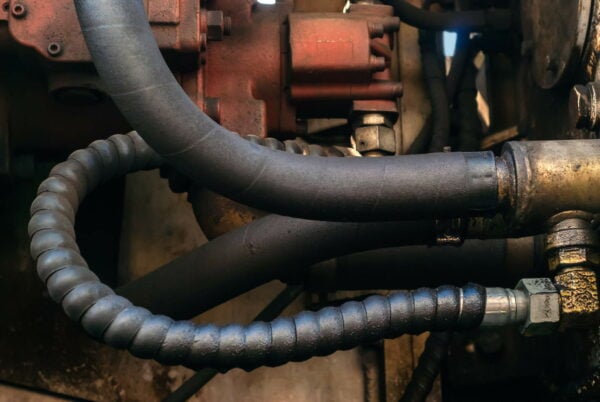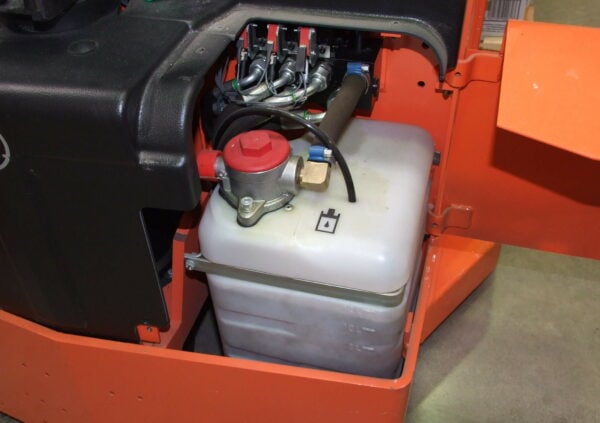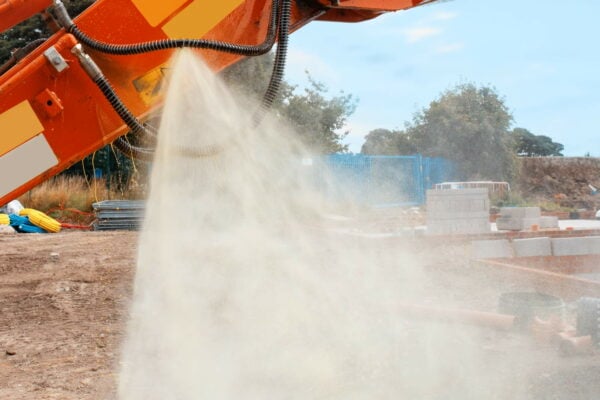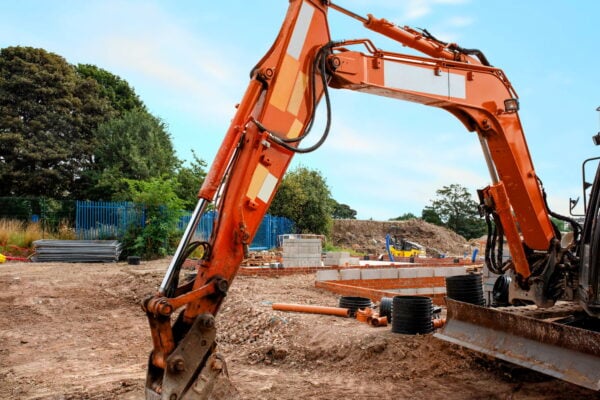What do hydraulic systems do?
Hydraulic systems are used to raise, lower, turn, contract, expand, turn and otherwise move attachments and parts of many different types of equipment such as forklifts, backhoes, excavators, loaders and truck loader cranes. When an excavator slews around, hydraulics power this. When a forklift lifts a pallet, hydraulics power this, too.

As part of the pre-operation check, the hydraulic systems must be inspected and the operator must be certain that there are no leaks and that the parts of the machine operated by the hydraulic system are working correctly. If you don’t know how to do a forklift pre-inspection check, we teach this and give you a comprehensive downloadable checklist as part of our forklift operator’s certificate course. The same is true in our truck loader crane course.
A pinhole leak in a hydraulic hose can produce a jet of hydraulic fluid so powerful it can penetrate skin and enter a person’s bloodstream. A sudden failure can cause attachments to drop immediately. This is why it’s important that checks are done on schedule.
How do you know if hydraulic fluid is leaking?
There may be obvious signs of a leak, such as puddling on the floor. The operation of the machine and attachments will be slower as the system cannot build up as much pressure. You might notice noises, or get a warning about the hydraulic fluid temperature.
Checking the hydraulic fluid
Always ensure that you are in control of the key to the machinery when you are checking the hydraulic systems. If another person starts the machine while you are checking the engine, this could cause injury. The manufacturer’s documentation will tell you exactly how to check the hydraulic systems; the following is a general set of instructions that will be suitable for many machines. The hydraulic oil is stored in a tank (“reservoir”), so you’ll need to find that.
To check the hydraulic fluid level, park the machine on level ground with the engine off and all attachments such as forks, booms either lowered, in the travel position, completely folded so that all hydraulic rams are in (giving the maximum amount of hydraulic fluid back in the reservoir, or in a position where you can view the levels; check the manufacturer’s instructions. It’s important that the fluid is cold as it expands as it heats. Some machines have a sight glass where the level can be seen. In some machines, this is visible from the cab, but in others you need to open an access door or the engine compartment. Other machines have a dipstick (this is usual for forklifts). If there’s a dipstick, it is usually (but not always) red, as will be the cap on the reservoir.

In general, if the level is under the minimum, start the machine and operate the attachments through several cycles to get rid of air within the system. Turn the machine off to make sure the fluid is not under pressure, then add hydraulic fluid to bring it back up between the minimum and maximum levels. Don’t overfill it otherwise there’s no room for expansion of the fluid.
Look for leaks around the rams, seals and hose connections. Wearing PPE (gloves, goggles) check the leak with cardboard, never your bare skin as hydraulic fluid is corrosive and you can get an injection injury (where pressurised hydraulic fluid is injected into your body). Use a mirror or cellphone camera to get into areas that are difficult to see.
Hydraulic hoses degrade over time with exposure to UV rays from the sun, and vibration against one another. The lifespan of a hose with a twist in it can be much less than one without a twist, so it’s important that the hoses are installed by a qualified person.
If you have found a small leak at a connector, try tightening it (they can work their way loose with the vibration of the machine). However, don’t overtighten a fitting – the reason it’s leaking could be because it’s already been overtightened. If it’s from a hose or ram it may be able to be sealed with a hydraulic leak sealant which is poured into the reservoir. Follow the instructions on the bottle. If this doesn’t work, the affected hoses and/or seals will need to be replaced.
Assuming you have found no leaks, start the machine. Run the attachments through one complete cycle. This is to check that the pressure running through the hydraulics is tested properly and it should highlight any leaks.
What to do if the hydraulic system springs a leak
If the leak is large enough, it could cause attachments to immediately drop to the ground. Some machinery has protection valves to stop this happening.


Lower all attachments and turn off the machine. Depower the hydraulic system to avoid additional leaks. You can do this by neutralising all the controls after you have turned the machine off, i.e. operate all switches and levers at least once with the machine off as this will remove any residual pressure in the system.
How to reduce the risk of a hydraulic leak
- Store your machinery out of sunlight when possible
- Keep hoses clean and ensure they are not rubbing on one another
- Change the hydraulic fluid as per the manufacturer’s recommendations
- After using the machine, lower all attachments, turn the machine off, then neutralise the controls. This means that you move the controls with the engine off. This reduces the pressure in the hydraulic system so that it doesn’t remain pressurised until the next time it is turned on
- Don’t overload your machine
- Keep the hydraulic cooler clean
- Keep enough hydraulic fluid in the reservoir.
Changing the hydraulic fluid
Hydraulic fluid breaks down over time and loses its ability to lubricate the hydraulic systems. The main cause of deterioration is heat. As it accumulates dirt, this affects the internal systems such as the filter causing wear and tear, overheating and, ultimately, a breakdown. This is why machinery will usually have its hydraulic fluid changed at least once a year and usually twice or more, but it depends on how often it is used, and under what circumstances.
If your machine has a hydraulic cooler with fins, rinse it frequently to remove dust and dirt (don’t use a water blaster).
What hydraulic fluid should you use?
Follow the manufacturer’s recommendations. Hydraulic oil is for conveying power in hydraulic machinery. It is different to engine oil which is for lubricating hot surfaces during fuel combustion. While engine oil would theoretically work as hydraulic oil, you may invalidate the warranty.
How to clean up a hydraulic fluid spill
You’ll need a spill kit. If you don’t know how to use a spill kit, take our spill kit training course. You’ll need to constrain the spill then use the kitty litter component of the spill kit to absorb the oil. Smaller granules are better. Follow the spill kit training and instructions to soak up the oil, collect it up and dispose of it. Finally, use detergent or baking soda and water to remove any last residues.

